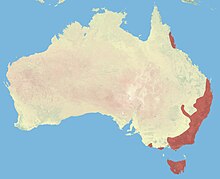| Tiger quoll[1] | |
|---|---|

| |
| Scientific classification | |
| Domain: | Eukaryota |
| Kingdom: | Animalia |
| Phylum: | Chordata |
| Class: | Mammalia |
| Infraclass: | Marsupialia |
| Order: | Dasyuromorphia |
| Family: | Dasyuridae |
| Genus: | Dasyurus |
| Species: | D. maculatus
|
| Binomial name | |
| Dasyurus maculatus (Kerr, 1792)
| |
| Subspecies | |
| |

| |
| Range of the tiger quoll | |
The tiger quoll (Dasyurus maculatus), also known as the spotted-tailed quoll, spotted quoll, spotted-tailed dasyure, or tiger cat, is a carnivorous marsupial of the quoll genus Dasyurus native to Australia. With males and females weighing around 3.5 and 1.8 kg (7.7 and 4.0 lb), respectively, it is the world's second-largest extant carnivorous marsupial, behind the Tasmanian devil. Two subspecies are recognised; the nominate is found in wet forests of southeastern Australia and Tasmania, and a northern subspecies, D. m. gracilis, is found in a small area of northern Queensland and is endangered.
The tiger quoll commonly preys on small mammals, insects, birds, domestic poultry and large marsupials such as wombats. It mostly hunts live prey but occasionally scavenges when the opportunity arises. The tiger quoll kills its prey by executing a killing bite to the base of the skull or top of the neck, depending on the size of the prey. The species is listed as near-threatened on the IUCN Red List, and is primarily threatened by habitat loss caused by human activities.
- ^ Groves, C. P. (2005). Wilson, D. E.; Reeder, D. M. (eds.). Mammal Species of the World: A Taxonomic and Geographic Reference (3rd ed.). Baltimore: Johns Hopkins University Press. p. 25. ISBN 0-801-88221-4. OCLC 62265494.
- ^ Burnett, S.; Dickman, C. (2018). "Dasyurus maculatus". IUCN Red List of Threatened Species. 2018: e.T6300A21946847. doi:10.2305/IUCN.UK.2018-2.RLTS.T6300A21946847.en. Retrieved 19 November 2021.
- ^ "Dasyurus maculatus maculatus (Tasmanian population) — Spotted-tail Quoll, Spot-tailed Quoll, Tiger Quoll (Tasmanian population)". Archived from the original on 4 March 2021. Retrieved 8 February 2020.

